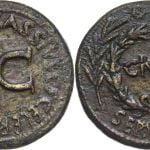Roman bankers appeared in the 3rd century BCE. Initially, they were called trapezitai in Greek, but then the Latin name argentarii came into use.
Argentarii did business in the taverna in the Forum, near the Temple of Castor and Pollux. Bad business conduct could end in bankruptcy for the bankers. Bankruptcy was referred to as foro cedere, foro abire or a foro fugare, “escape from the forum”. Such a strange combination of words resulted from the fact that the presence on the forum was the duty of a man doing business. In this way, he gave proof of his solvency. Leaving the square led to the obvious thesis that the banker was involved in shady business.
Bankers took deposits, made loans, exchanged money, and sometimes conducted auctions for a one-per cent commission. A specific operation was the receptum argentarii agreement, in which the banker guaranteed his client’s loan from a third party, becoming indebted to the latter in the event of the client’s insolvency. Over time, this operation was replaced by constitutum debiti alieni, i.e. an informal obligation to pay someone else’s debt. Such solutions enabled the development of new credit operations.
Each banker was obliged to keep two types of books: adversarium and codex rationae mensae.
- Adversarium was a cache journal where a hacker recorded operations in chronological order.
- Codex rationae mensae was a collection of customer accounts divided into debit side (expensum ferre) and credit side (acceptum ferre).
A citizen, as mentioned earlier, could apply for a loan. Roman law knew two types of loans:
- Nexum was drawn in a solemn manner “with bronze and weight” (per aedes et libram). The creditor could sell the debtor into slavery (legis actio per manus injection).
- Mutuum was an informal loan that succeeded in displacing the older nexum.
Interest (foenus or usuriae) was treated as remuneration for the use of someone else’s capital. They were an interest-bearing loans, unlike mutuum, an interest-free friend loan. The loan contract itself usually did not result in interest, a separate agreement was concluded on this subject, often in the form of a solemn oral promise (stipulatio). Sometimes interest was assumed to exist by operation of law, especially in proceedings based on the so-called good faith (bona fides).






